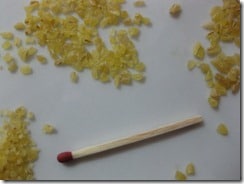Bulgur wheat is one of my favorite grains. I consider it one of nature’s “fast foods.”
Also known as cracked wheat, bulgur is made from steaming or parboiling whole kernels of grain, then grinding them into various sizes. Because it’s pre-cooked, it needs little additional cooking. Some recipes, like traditional tabbouleh salad, only require soaking.
I went out to get a few sizes of bulgur so you can compare. Click on the picture to enlarge. The match is for size reference.
Cooking times and amounts may vary, depending on the age and quality of the grain. My cooking times are shorter than is sometimes recommended. Turn off the heat and let sit for another few minutes before opening.
- Fine bulgur. Pictured on the lower left. It’s similar to rough cornmeal. Either soak it, or boil it in twice the amount of water or stock. After boiling, turn off the heat, cover the pot and wait until all the liquid has been absorbed, about four minutes.
- Medium bulgur. Pictured in the middle. Use twice as much liquid or stock. Boil and soak for 15 minutes, or cook for 5 minutes on low heat.
- Coarse bulgur. On the right. There was less difference between the coarse and medium bulgur, then between the medium and the fine grain. Use 2-1/4 cups liquid for every cup of bulgur. Bring to a boil, lower heat and simmer for 10 minutes.
- Extra-coarse bulgur (not pictured). Here the wheat is barely ground, if at all. Boil 2-1/4 cups liquid for every cup of bulgur. Cook for 20 minutes.
Variations:
You can season bulgur like any other grain. Cooking Outside the Box has ideas for homemade seasonings to mix with your bulgur in advance.
Other ideas:
- Saute onion or other vegetables before adding the bulgur and liquid.
- Toast the bulgur in a small amount of oil or butter before adding the liquid.
- Soak bulgur in the evening, then warm in the microwave for a quick breakfast with fruit and milk or yogurt.
- Add to soups, stews, hamburger, or anything that needs a quick thickener.
- Try it as a breading for fish or chicken fillets.
- Think of bulgur any time you need a quick side dish, or if extra company turns up. Like most whole grains, extra cooking doesn’t usually hurt.
Keep in mind that bulgur is a wheat product and contains gluten. Store raw bulgur in the freezer whenever possible.
You may also enjoy:
Don’t Bite the Bugs: How to Prevent Insect Infestation


I love bulgur and use it all the time, as a side dish and in salads. I also add some to my homemade breads for extra texture.